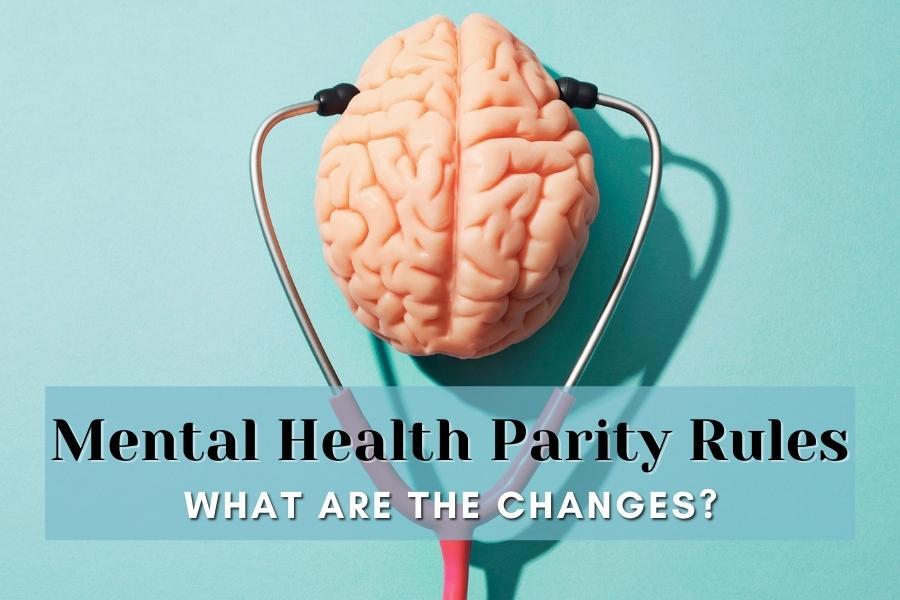Get in touch
408-366-8880
mymail@mailservice.com

Mental Health Parity Rules: What Are the Changes?
The efforts to recognize mental health issues as critical as physical issues have gone on for several decades. Finally, in 1996, the Mental Health Parity Act (MHPA) was enacted to prohibit large group health plans from imposing limits on mental health benefits, especially when less than favorable limits were imposed on surgical or medical benefits.
The Paul Wellstone and Pete Domenici Mental Health Parity and Addiction Equity Act of 2008 (MHPAEA) is a U.S. federal law that preserved the MHPA and added significant new protections to it. The MHPAEA was designed to evolve and ensure a balance of attitude and treatment for mental and physical illnesses and conditions. More than a decade old, the Act has undergone some changes to suit a rapidly changing society and its population’s needs.
Are you and your HR team up-to-date on the changes made to this vital Act over the years? If you’re not up-to-date, we can help you ensure that you are current and compliant in providing peak mental healthcare resources when your valued employees need them.
MENTAL HEALTH PARITY: WHY IS IT SO VITAL FOR EMPLOYERS TO PUT MENTAL HEALTH MATTERS ON EQUAL FOOTING WITH PHYSICAL HEALTH ISSUES?
Looking at the workplace alone, psychological health is invaluable for employees to attain, maintain, and enjoy work-life balance. Working 40 hours or more can take its toll on employees who are working hard to ensure optimal productivity while at the office and juggling family responsibilities and private pursuits.
The National Alliance on Mental Illness (NAMI) expounds on the seriousness of mental illness in our society, citing millions of U.S. citizens suffer from some type of psychological condition or illness each year. For several decades, organizations such as NAMI, Substance Abuse and Mental Health Services Administration (SAMHSA), Centers for Disease Control and Prevention (CDC), and the U.S. Department of Justice have monitored the state of mental health to determine how to help those suffering.
Here are some compiled statistics from 2019 to help you understand the possibilities that one or more of your valued staff members might suffer from a psychological condition that requires professional healthcare assistance:
- 5 million (20.6%) U.S. adults experienced mental illness, representing one in five adults.
- 5 million (3.8%) U.S. adults experienced a co-occurring substance abuse disorder along with a mental illness diagnosis.
- 8% of U.S. adults sought and received treatment for mental illness.
- 9% of U.S. adults with mental illness had no health insurance coverage for treatment.
The fallout from untreated mental illness and substance abuse can be tremendous, turning into physical manifestations that could ultimately cost businesses and insurance carriers far more money than addressing the initial psychological issue.
For example, people suffering from depression have a 40% greater risk of developing cardiovascular and metabolic diseases and conditions than others. Even worse, people with serious, unchecked mental illness are nearly twice as likely to develop these dangerous conditions.
With all this in mind, it is vital to help ensure that your employees enjoy good mental health as much as good physical health since they are so inextricably intertwined. You don’t want your valued employees to suffer from any underlying conditions that today’s insurance plans need to address. The MHPA and MHPAEA made it easier for you to provide healthcare strategies that include mental health and substance disorders.
WHAT IS THE BACKGROUND OF THE MHPAEA?
Historically, mental health issues have rarely been placed on equal footing with physical health issues. However, mental health conditions of all kinds are rampant in today’s society.
In 2018, the FindLaw team shared that:
“Today, tens of millions of Americans suffer from some form of mental disorder, including but not limited to depression, anxiety, substance abuse issues, asocial or antisocial tendencies, and others. Mental health issues have become so widespread that many psychiatric professionals have likened it to an epidemic, prompting federal lawmakers to pass legislation ensuring mental health coverage by insurers.”
The MHPAEA was designed a decade before that statement to address ever-increasing mental health issues that we as a nation and business community face. Despite the Act’s passing and adoption, mental health sufferers still struggle to receive the same consideration for their struggles as those suffering from physical maladies and the respective necessary treatments, such as medicine, physical therapy, and surgery.
WHAT IS THE MHPAEA AND WHAT DOES IT DO?
Fortunately, over the past several decades, the opinion of the seriousness of psychological and mental health disorders has shifted, thanks to the psychological community’s shared insights into the psychological ills pervading society. Further, lawmakers have listened to these insights and have sought to help serve this growing community of people who feel lonely and abandoned by a thriving healthcare industry and employers.
In its original iteration, the MHPAEA applied group health plans and group health insurance. In 2010, the Act was amended by the Patient Protection and Affordable Care Act and was later amended once again by the Health Care and Education Reconciliation Act of 2010. You might know all of this better as the Affordable Care Act (ACA), which also applies to comparable health insurance coverage.
WHAT DOES THE MHPAEA AND ITS SUBSEQUENT UPDATES MEAN TO EMPLOYERS WITH GROUP HEALTH PLANS?
With group health plans, employers with 50 or more employees can provide them with the option of traditional insurance plans purchased from an insurance carrier in the group health insurance marketplace. Self-funded plans are also compatible with the Act. With these types of plans, the power is placed in the hands of the policyholders, who pay for coverage directly without working through an insurance issuer.
WHAT PROTECTIONS HAS THE MHPAEA ADDED TO THE ORIGINAL MENTAL HEALTH PARITY ACT?
One of the most significant expansions that the MHPAEA offered over the original MHPA is coverage for substance use disorders. However, the MHPAEA on its own did not allow for mental health and substance use disorders (MH/SUD) for small group plans. Instead, it was only applied to large group health plans and health insurance issuers who chose to add mental health and substance disorder coverage.
The ACA built on MHPAEA now requires MH/SUD benefits as one of ten essential health benefit (EHB) categories to be included in non-grandfathered and small group plans.
WHAT RECENT CHANGES HAVE BEEN MADE TO THE MENTAL HEALTH PARITY ACT?
As you’ve already seen, mental health issues and the way we address and need to address them are in a constant state of evaluation and change. It’s no surprise that the advent of COVID-19 in early 2020 created and exacerbated mental health issues like depression and anxiety.
Everyone was trying to navigate some dark waters during that time. Some still are, but think about those who already struggled to manage mental health issues before a slew of restrictions, lockdown orders, layoffs, and unfamiliar and isolating remote work scenarios came to pass.
Although the Consolidated Appropriations Act of 2021 (CAA) was not related to or spurred by COVID-19, the Act couldn’t have come along at a better time. Enacted in April 2021, the CAA requires group health plans and issuers to cover MH/SUD and medical and surgical (M/S) benefits to compare the two to determine non-quantitative treatment limits (NQTLs) that are applicable.
As of February 10, group health plans need to supply the resulting analysis and any other information if requested by relevant federal regulators, such as the DOL.
Many of the new initiatives associated with the MHPA actually came in response to the 2016 enactment of the 21st Century Cures Act, requiring federal agencies to issue guidelines for MHPAEA compliance to improve parity for NQTLs.
Under the CAA, there are several pieces of data that plans must provide to the DOL, including:
- Terms, including the specific plan and coverage terms regarding NQTLs for MH/SUD and M/S benefits. The terms must also include which of the six parity classifications covers the specific benefit, such as pharmacy, in-patient and in-network, or out-patient and in-network.
- Factors used to determine that the NQTLs should be included in the benefits.
- Comparative analysis of each NQTL for benefits in each classification ensures that each applies to MH/SUD benefits comparably to those applied to M/S benefits.
- Findings and conclusions, featuring the comparative analysis results, determine whether the plan or issuer is or is not in compliance with the Mental Health Parity Law.
Finally,
FAQ 45 offers some suggestions regarding details that health plans should and should not provide to the relevant federal department to whom they report.
ARE YOU COMPLIANT WITH ALL THE MENTAL HEALTH PARITY RULES?
As you might note, mental health and substance abuse professionals and lawmakers have worked hard over the past several decades to help provide equal care to MH/SUD and M/S insureds. Unfortunately, it isn’t always easy to keep up with all the new Acts and updates that apply to your company and your valued employees.
Besides not wanting any of your employees who may suffer from mental health and co-occurring substance disorders to slip through the cracks, there are now several checks and balances in place to ensure that you remain compliant in providing the necessary coverage for all employees.
At KBI Benefits, our team works hard to keep up with every update regarding Mental Health Parity Rules to help you remain compliant, protecting your business and employees. If you need more help navigating this complex and continually changing matter, we can help.
Contact our team today to learn more about the MHPA, MHPAEA, CAA, or any other benefits-related matters on your mind!
Services
Latest Thinking




